#Rat Terrier Devotees
Text
does anyone wanna join my Freerice group? Code to join: 2ZJPCWMH
So, like, Freerice is that trivia game that the World Food Programme does to raise money to acquire & distribute food donations to hungry populations around the world, especially in areas with emergency-level starvation rates and potential/imminent famine (like Palestine, South Sudan, Democratic Republic of the Congo, for example).
(It used to generate money purely through ads, but more recently they've secured several sponsors to fund the donations their site generates instead, bc it's apparently more reliable and consistent that way.)
My Freerice group name is "Rat Terrier Devotees" (because I have a Teddy Roosevelt Terrier) and the code to join is: 2ZJPCWMH
#non music related#not music related#freerice#Sudan crisis#democratic republic of congo food crisis#free palestine#genocide in palestine#palestinian starvation#imminent famine in Palestine#world food programme#Freerice game#Free Rice#Rat Terrier Devotees#personal
1 note
·
View note
Text
Summary of this long-ass post: If u wanna join my Freerice Group, the joining code is: 2ZJPCWMH and anyone & everyone is welcome to join!
This is probably incredibly sick and f*cked-up of me and like a very vile part of my ED-brain, but one way I try to assuage the intense guilt I feel from restricting/fasting (seemingly) by choice, while there are devastating & unspeakably horrific hunger & starvation crises occurring throughout the world, is by spending my free time doing those "click-to-help" donation site thingies to fund aid and food donations to starving populations (the two I use most are Arab.org in their Click-To-Help section https://arab.org/click-to-help/palestine/ and The Hunger Site (although I have read some very sus things about them on reddit??? I only really resort to this one bc my middle school health teacher had us do this one every day for a week, so I implicitly trusted her judgment for years bc she was known for having 6 prior mar!juana possessions on her record).
Anyways, the other thing I do daily is I play the Freerice game (you can find it on the World Food Programme Website). It's a free trivia game where as you play, you generate donations (the site was previously were funded purely by ads, but recently they were able to acquire several large sponsors to cover the donations instead, since they said it's more consistent and reliable that way) for the World Food Programme, which uses the money to organize and distribute food aid all over the world-- but especially to populations suffering from emergency-level food insecurity and starvation rates (such as in Palestine, South Sudan, Democratic Republic of the Congo, etc-- there's a list on the WFP website of the areas that are under the "Emergencies" section).
p.s. The "grain of rice" in the game don't represent actual real grains of rice, they're just a conceptual representation to help you visualize the worth of your donations adding up.
anyways. So what my mentally ill brain does is: for every "bowl of rice" (a certain donation amount) I do on Freerice, my ED-ass thinks, "Oh good, for every 'bowl' I 'fill' it's literally keeping me distracted from binge-eating and INSTEAD, all the food I COULD have been eating in that time I was playing-- I can use that distraction from eating to generate legit food donations for real starving people who actually WANT to eat and desperately NEED the nutrition. As far as coping-mechanisms go, this one isn't so bad!"
That's how my brain-fogged, guilt-ridden mind works. I'm so ashamed of choosing to deny myself food, when I know for a fact that there's stuff going on in the world like the Israeli government using forced-starvation as a tool to commit genocide against Palestinians by creating and maintaining a man-made famine. So i try to mentally justify my ED behavior by imagining that the time i spend not-eating while playing Freerice is a way of somehow magically transferring my ~potential food ingestion~ to another person somewhere else who ACTUALLY needs it.
ANYWAYS, my point to all this rambling is that I wanted to offer my Freerice Group Code to anyone on EDblr (or just anyone in general) who might want to join my Group and collectively track the donations we generate together :')
My Freerice Group name is "Rat Terrier Devotees" (bc I have a Teddy Roosevelt Terrier lol) and the Group Code is: 2ZJPCWMH Please feel free to join (regardless if you're EDblr or not, obvi)!
#personal#rant#tw ed#tw eating dis0rder#tw mental illness#tw ed behavior#tw 3dblr#tw edblr#freerice#world food programme#south sudan crisis#democratic republic of the congo food emergency#free palestine#genocide in palestine#palestinian starvation crisis#imminent famine in palestine#food aid for Palestinians#freerice trivia game#click-to-help sites#tw food mention
2 notes
·
View notes
Text
Hear Me Out:
A Series Of Unfortunate Events AU set in the His Dark Materials universe. The plot is still basically the same, except everyone has daemons. Violet is the only Baudelaire whose daemon is settled, and he takes the form of a hedgehog (apparently they represent protection and resourcefulness, which felt appropriate for Violet.) Klaus's and Sunny's daemons still shift a lot, though Klaus's is fond of an owl shape, and Sunny's most common forms are a Jack Russell terrier puppy, a wolf cub and a baby snake.
Basically, everyone in the unfortunate gen apart from Violet and Fiona have unsettled daemons. I'm not sure what form Fiona's daemon should take, though.
The guardians have a variety of daemons, naturally. Olaf has a chameleon, Monty has a python, which he is very open about, leaning more into the "wisdom" side of the "wisdom and cunning" serpent symbolism. Josephine has an eagle, which was once as fierce and formidable as she was, but, just like her, lost his courage and is almost too afraid to fly when the Baudelaires meet him. Charles has a beaver, and Sir has a rat. Nero has a parrot, who shares his habit of mockingly repeating people when they talk. Esmé has a goose, and Jerome has a dog, who's just as eager to please as he is. Hector has a duck- in fact, everyone living in the Village of Fowl Devotees has a bird daemon of some description. Sometimes people's daemons settle as something else, but they usually end up leaving. It's not technically against the rules, but it may as well be.
Most of the people in VFD have quite small daemons that can easily be hidden. This is particularly true for the Denouement brothers, as their daemons are the easiest way to tell them apart, and if anyone saw Dewey's daemon that wasn't supposed to- and was aware of what Frank's and Ernest's daemons look like- it wouldn't be great. The other volunteers are careful about their daemons too- though some find it harder than others. Particularly Beatrice and Bertrand, who have a bat daemon and a jackdaw daemon respectively, and know exactly which one is less conspicuous.
The whole idea of daemons in relation to VFD is interesting to me, actually. Like, how difficult would that make maintaining disguises? Would it make things hard for the child recruits? How would Olaf be able to fool everyone so many times if he, Esmé and the troupe always had the same daemons? Would Olivia have to hide her daemon under the table when she was pretending to be Madame Lulu? For that matter, would Violet or Klaus have to hide one of their daemons when they were pretending to be Beverley and Elliott?
This AU raises so many questions, and I love it already.
#a series of unfortunate events#asoue#his dark materials#bbc his dark materials#a series of dark materials#violet baudelaire#klaus baudelaire#sunny baudelaire#count olaf#monty montgomery#josephine anwhistle#asoue charles#asoue sir#vice principal nero#jerome squalor#esme squalor#asoue hector#dewey denouement#frank denouement#ernest denouement#beatrice baudelaire#bertrand baudelaire#olivia caliban
154 notes
·
View notes
Photo

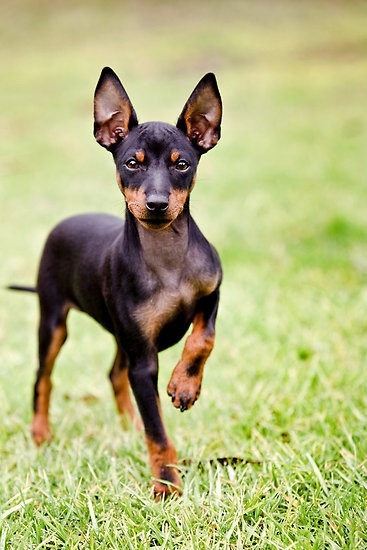
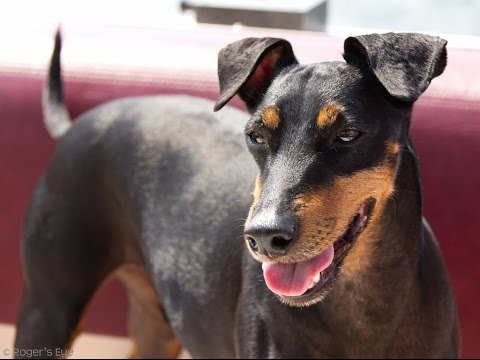
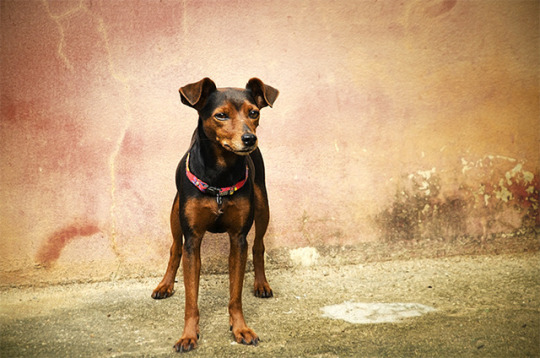
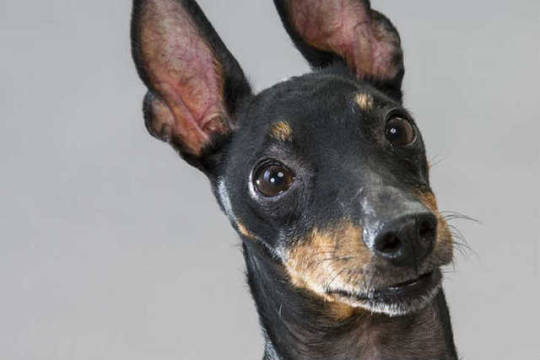
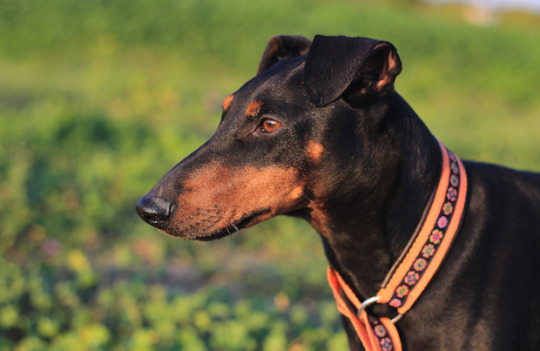
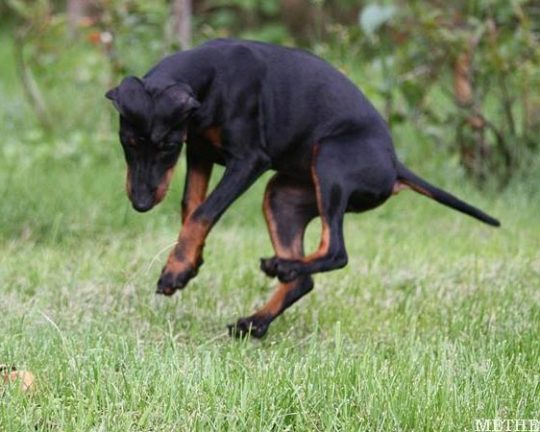
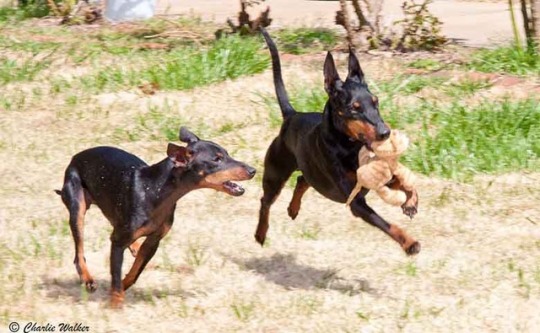
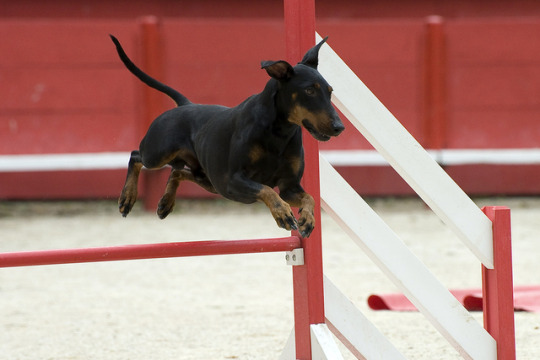

Manchester Terrier
The Manchester Terrier is a breed of dog of the smooth-haired terrier type. In North America, the Manchester terrier is divided into two varieties. The toy Manchester terrier was originally recognized as a separate breed in 1938, bred down in size from the Manchester terrier. The toy Manchester terrier weighs less than 12 lb and has naturally erect ears, never cropped. The Standard Manchester terrier weighs 12 to 22 lb and has three allowable ear types (naturally erect, button, or cropped). Other than size differences and ear type, the Manchester terrier and the toy Manchester terrier have the same overall appearance, and since 1958 have been varieties of the same breed. This breed has maintained consistency in type and appearance for nearly two centuries (at the very least).
Manchester terriers are considered by most to be the oldest of all identifiable terrier breeds, finding mention in works dating from as early as the 16th Century. In 1570, Dr. Caius (Encyclopedia of Dogs) gives mention to the black and tan terrier, though he referred to a rougher-coated, shorter-legged dog than we are now accustomed to. By the early 19th Century, a closer facsimile to the current Manchester terrier had evolved. In The Dog in Health and Disease by J. A. Walsh, a full chapter was devoted to the black and tan, for the first time recognising it as an established breed. The description given by Walsh is still relevant: Smooth haired, long tapering nose, narrow flat skull, eyes small and bright, chest rather deep than wide, only true colour black and tan.
The early 19th century saw times of poor sanitation in England. Rats soon became a health menace and rat killing became a popular sport. John Hulme, enthusiastic devotee of the sport of rat-baiting and rabbit coursing, crossed a whippet to a cross-bred terrier to produce a tenacious, streamlined animal better suited to the sport. This cross proved so successful that it was repeated, resulting in the establishment of a definite type. Ears were cropped to save risk of being torn in frequent scraps. (This also enhanced the sharp appearance of the expression).
When rat-killing became illegal in England, rat-pits were supplanted by dining halls or public inns, all of which were infested by rats. To combat the rodent problem, each inn kept kennels. By 1860 Manchester was the breed centre for these "Rat Terriers", and so the name Manchester terrier became established. Smaller specimens began to gain appeal. Smaller Manchesters were carried in specially designed leather pouches suspended from the rider's belt, earning the title of "Groom's Pocket Piece". With their smaller stature, these dogs obviously could not keep up with the hounds, but when the hounds ran the fox into dense thickets they were not able to penetrate, the little Manchester terrier was released. The breed was nicknamed the "gentleman's terrier".
#canine abc's#M#manchester terrier#standard manchester terrier#toy manchester terrier#dogs#source: google
56 notes
·
View notes
Text
The World of the American Pit Bull Terrier - Chapter Two
CHAPTER TWO
“History is indeed little more than the register of the
Crimes, follies, and misfortunes of mankind.”
Gibbon
“The world loves a spice of wickedness.”
Longfellow
Tracking the Demon
Although the origins of the American Pit Bull Terrier are shrouded in the mists of time, my personal speculations are reinforced whenever I take Judo off his chain. Although normally a quiet dog, Judo has a real passion for fighting; and for that reason, when he is taken off the chain for whatever reason (usually a walk), he hurls himself at every dog on the place, bellowing at them. This, in turn, stimulates the other dogs to go absolutely bonkers about trying to get at him. In the ensuing hullabaloo, I can detect two or three voices, including Judo’s, that have a hound-like quality to them. For those who have not heard hounds bay on the trail (for that is different from their baying bark in the kennels), their voices carry an almost agonizing ecstasy and yearning. Judo’s voice would never be mistaken for that of the famous Bugle Ann, but it nonetheless had the same urgency and delicious delirium as hat of a hound’s.
Now, lest the reader jump to conclusions, I am not implying that Pit Bulls are descended from scent hounds. However, I do think that Pit Bulls and all hounds have a common ancestry (perhaps thousands of years back in time). Who knows when mankind and canines first cooperated in the hunt? But it must have been tens of thousands of years ago, and it probably was the first practical use of dogs by mankind. Hunting was serious business then, but undoubtedly most men also enjoyed the hunt; and the dogs that also liked it and excelled in it were perpetuated. We’re assuming, of course, that mankind knew nothing of selective breeding in those days, but it is easy to picture how the less enthusiastic and skillful dogs were not allowed to partake in the spoils of the hunk and, perhaps, were driven off or even killed. This would be indirect selective breeding by culling out the less useful animals.
The dogs aided in the hunt by helping to track the game, then by running it down, and, finally, by killing it. Eventually, specialization evolved. Thus, dogs with longer muzzles and heavy flews were likely better at tracking. The long-legged and slim-bodied dogs were swifter than the others, and they were most adroit at running the game down once in sight. The strong, powerful dogs that were most useful in the kill were not quite as swift but were nonetheless needed once the game had been run down.
Thus, both man and canine developed an appetite for hunting. With the advent of farming and technology, hunting was no longer needed and became recreational of a “sport”. Not all men or all dogs, for that matter, were allowed to hunt any longer. True hunting dogs were kept kenneled of chained when not hunting with their masters so they would not deplete the game or attack domestic stock. Stray dogs caught hunting were killed—and so were men. The men were called “poachers” if they hunted but weren’t part of the landed gentry, and the penalty for poaching was often death. There was a time when it was illegal for the peasants to even own a hound, for why else would they want one if not to hunt (or, rather, “poach”)? However, peasants were allowed to keep small dogs that were used to keep down “nuisance” animals such as rats, moles, and badgers; and the dogs that did this were called terriers. Unfortunately for the peasants, Bulldogs were generally thought of as hounds, and possession of them by peasants was forbidden. It is possible, even probable, that many a small Bulldog masqueraded as a terrier so that his owner could keep him. That may be the origin of the name “pit terrier” that the Irish often used for their dogs, while everyone else referred to them as Bulldogs. And there, too, may be a clue as to why the Irish pit dogs were so small.
In any case, it is easy to conceive how sports developed from the use of these three types of hunting dogs and the terriers. It is easy to see how hunters became interested in which was the fastest of the sight hounds and, thus, dog racing was born. Various tracking trials evolved for the scent hounds and are used to this day. And it is not hard to see how curiosity developed about which was the most formidable of the “kill dogs.” In my opinion, the matching of dog against dog originated much further back in history than most people think. To demonstrate the hunting-connected efficiency of the dogs, captive bears and bulls were used for what came to be called bearbaiting and bull-baiting. Butchers later used these dogs as catch dogs to secure a bull that was intended for slaughter. This practice, along with the bull-baiting, apparently fixed the breed with the name of Bulldog. Before that they were known (in various languages) as boar hounds, bear biters, bull biters, mastiffs, molossans, and ban (bound) dogs.
In the meantime the peasants, too, had their pastimes with their “terriers.” This, we hear of badger-baiting (or “drawing”) and rat-killing contests. Since many a peasant had a Bulldog (and Bulldog crosses) masquerading as a terrier, it can be strongly suspected that the poor, too, indulged in dogfighting.
Although people generally were concerned with dogs for what they could do, they also appreciated a good-looking dog (that was also good at his craft). A devotee’s idea of beauty was closely related to function, so perception of good looks tended to depend on the type of activity in which the dogs were involved. One of the first groups to develop conformation standards was a group of hunting dog people, and they began to put on shows for “sporting dogs.” As time passed, other people jumped on the bandwagon, asking to show their dogs, too. So now there were two categories, “Sporting Dogs” and “Non-sporting Dogs,” meaning hunting dogs for the first category and “all the rest” fitting into the second. This system is still used today in American Kennel Club conformation shows, except that many other categories have been added. Thus, we have such divisions as the “Toy” group for the lap dog set, “Working Dogs” for dogs that do farm work or guard work or anything else that could be construed as “work,” and the “Hound” group which includes both scent and sight hounds and which was developed for the people who felt that hounds were special enough hunting dogs to have their own category.
The system had its bugs, of course. One problem was that some breeds would fit into more than one category. Our own breed, for example, would be a hunting dog (or hound), a working dog (as a catch dog and guard dog), and even a terrier (since he was used for rat and badger killing). To mention just a couple of other examples, the Dachshund was mistakenly placed in the hound group, apparently because he classifiers thought the German hund translated to “hound” when it is actually “dog.” The Boston Terrier is placed in Non-sporting, and I suppose that is as good a place as any since the breed is certainly not a terrier. But then, why the appellation “terrier”?
The breakdowns in the system resulted from a combination of ignorance on the part of the people applying the system and the resistance of many breeds to being pigeon-holed under a single category. Nevertheless, the system has worked well for show purposes for many years now. The unfortunate part is that the public is mainly aware of show dogs only and have obtained their information about dogs, directly or indirectly, from American Kennel Club sources. Thus, misconceptions and fanciful ideas about dogs abound, for the stock-in-trade of show people has been the adoption of ridiculous and unsubstantiated histories for their breeds and the treatment of breeds not registered with the American Kennel Club as though they didn’t exist.
As one who has tried to ferret out the history of our breed, I can appreciate how easily misconceptions can be solidified into a breed’s official history. Fortunately, I have the advantage of viewing whatever historical evidence is available from the vantage point of being familiar with the Pit Bull in pretty much all his aspects: pit dog, catch dog, hunting dog, guard dog, house dog, and so on. Nevertheless, any student of any breed should maintain an attitude of skepticism toward all aspects of any breed history (including this one!), for histories are put together from various personal contacts, other writings (which may have borrowed from still other writings), artwork, old documents, and ancient artifacts. I get most annoyed with those histories which purport to trace a specific breed back to the ancient Egyptians. And yet, I can look at artifacts (or photographs of them) from that era and see dogs that look very much like ours and were being used like ours might be, too. However, I would never try to say that those dogs were our breed (Egyptian Pit Bull Terriers?), although I do think it is perfectly logical to think that our dogs are descended from that type of dog.
But getting back to more modern times, we have no way of knowing when the first importations of Pit Bulldogs were made, by my guess would be that they came over with the miscreants who were threatening all of Europe with civil war and who escaped or were driven over here. That would be prior to 1776, but, of course, this is sheer speculation. We do know from photographs that the dogs were here prior to the Civil War, and, of course, the importations that were pretty much concurrent with the Irish migrations resulting from the potato famine of 1845 to 1851 are fairly well known. Actually, what usually happened was that some of the few Irish who became immediately successful economically in this country then either went back to their homeland and brought back “pit terriers” or were sent them by relatives still living there. The Pit Bulldog has always had a particular appeal for minorities, and I’m not sure why. Most likely, oppression and hard work are more bearable when you have at home a dog that you know can whip every other dog in town. The fascination with a fighting dog can be almost pathological in its intensity, but it can also be a balm for the wounds and indignities suffered from an unjust society. In any case, since we know Pit Bulldogs were extant in various countries, it only figures that other immigrants were instrumental in bringing over dogs from their favorite strains and from various countries.
The population was concentrated in the New England areas, so, at least in the beginning, the dogs were mainly found there, too. But Pit Bull people are individualistic adventurers, the very types that would pioneer in opening up the wilderness areas. Thus, the breed moved South and West.
The breed continued to be, and is to this day, used for a variety of activities, including fighting and hunting as catch dogs, but, of course, the vast majority of people kept the dogs as pets or watch dogs. The pet owners usually knew pit dog men or, at least, breeders of pit dogs and often were students of the pit aspect of the breed. In other words, things were pretty much as they are today.
From every avenue of information, the indications are that the breed was simply call “Bulldog” by its enthusiasts. However, when Chauncy Z. Bennett started the United Kennel Club in 1898, he recognized the breed as “American Pit Bull Terrier.” The word “American” helped to distinguish the breed from the show Bull Terrier that was often referred to as the English Bull Terrier. However, Bennet had a decided preference for using the word “American” in his breed names. Thus, he had an “American Foxterrier” and an “American Coonhound” (and an “Old Glory Black and Tan”), and later on, the “Spitz” became the “American Eskimo.” For a while, he also registered white Collies as “Columbian Collies” (“Columbia” was another word for America that was more common earlier, as in the song “Columbia, Gem of the Ocean.”) Bennett was not necessarily an ultra-nationalist, but people felt that ours was a special country, and they were thus more likely to accept anything new or controversial if it had “American” in front of it. Bennet’s rationalization was that if a breed was developed or slightly changed in this country, then it could be called American. For a long time thereafter, there was a debate about whether the breed should be called “Pit Bull Terrier” to emphasize the acceptance of pit dogs or “American Bull Terrier” in order to promote the breed. “American (Pit) Bull Terrier” with the “pit” in parenthesis was Bennett’s solution.
When the American Kennel Club was petitioned to recognize the breed around 1935, the name American Pit Bull Terrier (or American Bull Terrier) could not be used because of the influential Bull Terrier people who felt they had a patent on the name “Bull Terrier.” (The Boston Terrier people who wanted recognition of the “Boston Bull Terrier” had been turned down for the same reason.) Another factor was that the A.K.C. didn’t want to use a name that had been utilized by the U.K.C. Will Judy, the publisher and editor of Dog World at that time, suggested “Yankee Terrier.” However, Staffordshire Terrier was the name decided upon, and the breed was placed in the Terrier Group, in which it is oddly out of place.
The English version of its pit dog had been recognized by the British Kennel Club as the Staffordshire Bull Terrier (apparently, the Bull Terrier fanciers over there were more reasonable or wielded less influence). For many years, people regarded the Staffordshire Terrier (“Staf” or “Staff”) and the Staffordshire Bull Terrier (“Stafford”) as the same breed, even though they had developed along entirely different lines and had different standards. Among show people, there has always been a fascination with imported stock. Thus, in the mid-1950’s, some Staf people imported Staffordshire Bull Terriers and bred them to their Stafs. Well, this set off quite a civil war among the Staf set, since many of them would not accept Staffords as being the same breed. Howard Hadley, one of the most reputable and influential of Staf people, led a successful fight to get the Staffordshire Bull Terrier declared a separate breed by the A.K.C. A problem then arose because the registry had two breeds with very similar names: the Staffordshire Terrier and the Staffordshire Bull Terrier. At this point, the Staf people, who had fought so hard for the name “American Bull Terrier” so long ago, were offered that name back—but they refused! Their reasoning was that they had spent over twenty years and thousands of dollars promoting the name “Staffordshire,” and they were now unwilling to give that up. This made absolutely no sense, of course, for the Staf had never become popular, and most people had no idea what they were. In any case, the name “American Staffordshire Terrier” was hit upon as a compromise and, the last I heard, is still the name being used.
In the meantime, a registry for registering Pit Bulldogs exclusively was started by Guy McCord in Chicago. It was the American Dog Breeders’ Association, and it registered the breed as “Pit Bull Terriers.” Later the registry was taken over by Frank Ferris who had married the widow of John P. Colby. In the early 70’s, the registry was purchased by the Greenwood family, and by this time, American Pit Bull Terrier (without the parenthesis) was the ADBA’s official name for the breed. Under the guidance of Ralph Greenwood, the registry grew tremendously in size and influence. Before that, the ADBA was just “that other outfit that registers Pit Bulls.”
The popularity of the Pit Bull rose and declined like all breeds, but it was always less popular than the top show breeds, for it received much less exposure than they did. Another drawback was that in the early days, people who kept dogs as pets let them run loose, as it was considered cruel to confine them in any way. A Pit Bull, however, had to be confined (kept in a fenced yard, in a kennel run, or on a chain), a definite inconvenience in those days. Still, the breed maintained a following among the general public, albeit not a large one. I recall Bob Wallace once complaining how people would ask him if one of his prize Pit Bulls that he happened to be out walking was “part Boxer.” Now, one of the reasons that that rankled Bob so much was that Boxers were a relatively new breed to him—after all, they had not become popular in this country until after World War II, whereas the Pit Bull was the “Grand Old Breed” to Bob. But I’ll bet that Bob would like to go back to the days when the breed was virtually a secret instead of the unofficial whipping boy of the humaniacs.
Aside from being kept as pets and watch dogs, the dogs were also being used as hunting dogs (usually as “still” trailers, but an occasional, though very rare, Pit Bull will give voice on the trail), stock dogs (usually as catch dogs, but a surprising number as all-around ranch dogs), and, of course, as pit dogs. The pit activity was pretty much rampant in all sections of the country, but each section lived in a world of its own. A specialized publication, such as Dog Fancy, Pit and Pal, or Pit Dogs, would occasionally came along and eventually go away. Bloodlines Journal, published by the United Kennel Club, was a constant source of information, but it contained match reports only from the pits down South. “Action” pictures of dogs in holds appeared vary rarely in this magazine, and during the mid-50’s, the match reports were discontinued altogether.
A variety of rules were used for the matches (see Appendix A), but in the mid-50’s, Gaboon Trahan and Floyd Boudreaux collaborated to write what came to be known as “Cajun Rules.” Similar rules had been written by Al Brown, but they were not in widespread use. In fact, there is a rumor that some top dog men from the West made up some new rules, called them “Cajun Rules” (feeling they would be more accepted that way), and sent them out to various key dog men. There were three main thrusts to the Cajun Rules, wherever they came from: (1) emphasis was placed on the hands of the handler being positioned in front of the shoulders (of the dog about to scratch); (2) a “turn” was more liberally defined as a dog simply turning his head and shoulders away from his opponent without regard as to whether or not it was a loss of interest in fighting—even a maneuver that resulted in the momentary turning away of head and shoulders was a turn; and (3) an out-of-holds count, varying from ten seconds to two minutes, could start the dogs scratching in turn, with the down dog to go first. The major impact of the Cajun Rules was to shorten the contests and thereby considerably improve the chances of preventing the loss of life of one of the dogs.
In the early 50’s, I.Q. Kennedy started a magazine called Pit Dogs. It caused quite a stir among Pit Bull people generally, as Bloodlines Journal had become more and more timid in their support of the breed and almost never mentioned pit contests. Now, here was a magazine that not only reported contest but also showed pictures of them. The magazine was quite successful and was later taken over by Pete Sparks. Although slickly done and full of information, the magazine (whose title was changed by Sparks to Your Friend and Mine) was certainly counterproductive to pit dog activity, as it focused attention on it. Rather, I should say it attracted humaniacs’ attention, and they used it as a red flag to wave in the faces of their constituents. Before long, pit dog conventions were being broken up by various agencies on a regular basis. For a time, Cuba was the perfect place for the conventions, but the Castro take-over ended that. Pit dog men learned to be a little more secretive about their activities. However, the magazine continued—and so did public pressure.
In the early 70’s Your Friend and Mine discontinued publication, but other magazines came out in its place. For that reason, public pressure continued; and in the latter seventies, the foolish proliferation of felony-intent dogfight laws began throughout the country.
During all this time, the breed had gained unprecedented popularity among the general public. The reasons probably varied. One was that since leash laws were becoming extant across the country, Pit Bulls were no longer a special problem as a pet. Another was the general public’s reaction to the increase in house burglaries. Many citizens obtained watch dogs, and the Pit Bull always had a good reputation as a solid watch dog, although they don’t really bark much and they like people—even strangers. If nothing else, however, their appearance is usually a deterrent. (I do think, though, that even the mildest of Pit Bulls would be unlikely to stand idly by if his owner were physically attacked, and I can’t think of any other breed I would rather have on my side!) Finally, all the publicity about the dogs generated by the humaniacs may have resulted in funds for their coffers, but it also engendered interest in the breed—and usually in the wrong people for the wrong reasons.
With this huge contingent of pet-owning Pit Bull People, organizations began to be formed. One of the first was the Golden State Pit Bull Club is southern California. In 1975, they asked the United Kennel Club for sponsorship of an American Pit Bull Terrier dog show. When that agency demurred, the group approached the American Dog Breeders’ Association, and they agreed to sanction conformation shows. First, a standard was needed, and the ADBA went about setting up one in a very organized way, looking at pictures of dogs known to be good wrestling pit dogs and analyzing them carefully. Other aspects of formidability, such as hard bite and pit intelligence, were not considered because there were no conformational aspects of these traits. Anyway, the shows became very popular, and now the American Dog Breeders’ Association has clubs holding shows across the country. While most participants are mainly interested in conformation, it has been amusing to see pit dog men also take part in these things and become quite caught up in them. Recently, weight pulls (as with sled dogs) have become a popular component of the conformation shows, and several Bulldogs have broken the weight pull record of sled dogs.
Some may worry that the shows will lead to a deterioration in the breed. Are today’s show people headed up the same trail that the Staf fanciers took so many years ago? Well, there is a decided difference in attitude today. The original Staf devotees (just as are today’s show people) were more an amalgamation of pit people, “reformed” (or retired) pit people, and simply fanciers of the breed. However, the tack taken was entirely different. It was decided (partly from pressure from the American Kennel Club) to completely disavow dogfighting and the badmouth it vociferously and persistently. All of this was designed to improve public acceptance of the breed and to throw off suspicion from Staf devotees. Neither objective was achieved. Even today the public lumps Staf people in with the pit dog people (why else would they want the dogs!), and the Staf people’s mealy-mouthed approach to the breed never did much to promote it.
Today’s American Dog Breeders’ Association show dog fanciers, conversely, revere a good game dog. They are fascinated by pit dog history and wouldn’t even consider breeding to a dog simply because it had good conformation. Rather, their interest is in perpetuating the essence of the breed, not just a hollow look-alike.
In hands such as these, the breed is well served. Some hare-brained politician in San Francisco wants to ban the breed? Before the proposal even comes before the Board of Supervisors, these people have mobilized the opposition to include even the humaniacs! Pass an ordinance against the breed in Hollywood, Florida? Okay, but be prepared for the civil suit filed by these people in which they have marshalled an impressive array of experts—some of them biologists and physicians who own Pit Bulls themselves. Although these things are expensive undertaking, they serve as warnings to other demagogues who cater to public panic and, pandering for votes, come up with various discriminatory ordinances against the American Pit Bull Terrier breed. They will, though, be held accountable in the final analysis for the unnecessary expenses they being on their constituents by arbitrarily and vacant-mindedly pushing for discriminatory (and, thus, unconstitutional) legislation.
I have often referred to these last few years as being an era in which American Pit Bull Terrier fanciers were being game-tested. While it has been a painful and discouraging time, it has also been one of weeding out the less serious and devoted owners. The breed will probably be better off for it. One of the beneficial effects I’ve noticed is that it has got what were once seemingly natural enemies working together. Thus, pit dog people, ADBA people, U.K.C. people, Staf people, Stafford people, and even Bull Terrier people are working side-by-side on certain projects—truly a sight to warm the atria of an old cynic’s heart!
Stratton, Richard F. Chapter Two. The World of the American Pit Bull Terrier. New York: TFH Publications, 1983. 9-13. Print.
#pit#pitbull#pit bull#americanpitbullterrier#american pit bull terrier#gamedogs#gamedog#working dog#dogs
0 notes